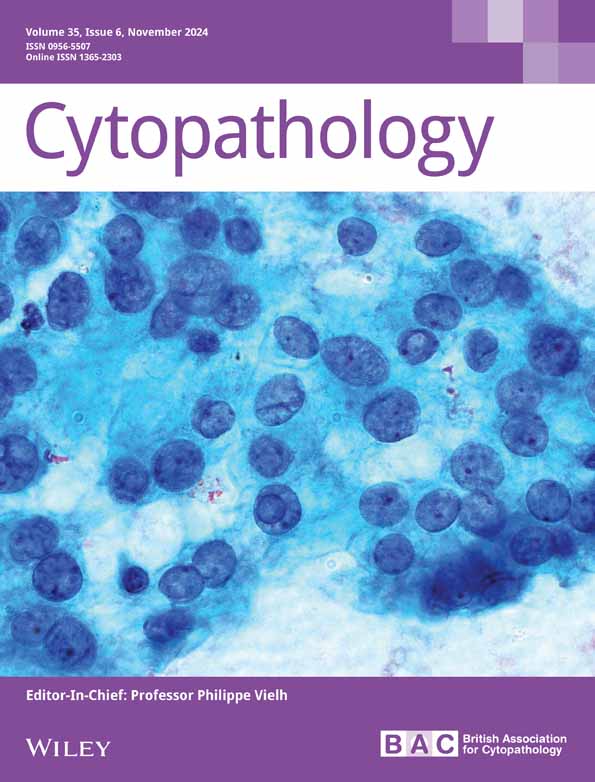Cytomorphological characteristics of low-grade papillary urothelial carcinoma in voided urine samples: Distinction from benign and high-grade papillary urothelial carcinoma
Abstract
Objective
Given its frequent recurrence and the potential for high-grade transformation, accurate diagnosis of low-grade papillary urothelial carcinoma (LGPUC) in urine cytology is clinically important. We attempted to identify cytomorphologic features in urine samples, which could be helpful for the identification of LGPUC.
Methods
We conducted a retrospective review of voided urine specimens collected from patients with histopathologic diagnoses of LGPUC. Their cytomorphological features were compared with those from patients with benign conditions and high-grade papillary urothelial carcinoma (HGPUC).
Results
A total of 115 voided urine specimens were evaluated, including 30 benign, 41 LGPUC, and 44 HGPUC cases. In LGPUC, 18 cases (44%) were diagnosed as atypical, a proportion significantly higher than that observed in benign cases (4 cases, 13%), while the remaining 23 cases (56%) were diagnosed as negative. LGPUC urine samples tended to have higher cellularity than benign cases, but the difference was not statistically significant. Three cytological features, namely nuclear enlargement, higher nuclear-to-cytoplasmic (N/C) ratio, and presence of small cell clusters, were statistically more prevalent in LGPUC compared to benign cases, although the changes were relatively subtle. In contrast, cytomorphological distinction between LGPUC and HGPUC was evident, as high cellularity, nuclear enlargement, hyperchromasia, high N/C ratio, irregular nuclear membrane, and apoptosis were significantly more prevalent in HGPUC cases.
Conclusions
Several cytomorphologic features in voided urine samples were more prevalent in cases with LGPUC, albeit not observed in all instances. Since these alterations were relatively subtle, meticulous attention to these cytomorphologic details is crucial to suggest the possibility of LGPUC.
Graphical Abstract
Several atypical cytomorphologic features such as nuclear enlargement, a higher nuclear/cytoplasmic ratio, and small urothelial cell clusters in voided urine samples were statistically more prevalent in histologically confirmed low-grade papillary urothelial carcinoma than in benign conditions. These atypical features were less pronounced compared with high-grade papillary urothelial carcinoma.
Low-grade papillary urothelial carcinoma (LGPUC) diagnosis in urine cytology is challenging. Several atypical cytomorphologic features such as nuclear enlargement, a higher nuclear/cytoplasmic ratio, and small urothelial cell clusters in voided urine samples were statistically more prevalent in histologically confirmed LGPUC than in benign conditions. These atypical features were less pronounced compared to high-grade papillary urothelial carcinoma. Therefore, meticulous scrutiny of cytomorphology is necessary for an accurate LGPUC diagnosis.
CONFLICT OF INTEREST STATEMENT
No conflict of interest is declared.
Open Research
DATA AVAILABILITY STATEMENT
The data that support the findings of this study are available from the corresponding author upon reasonable request.





